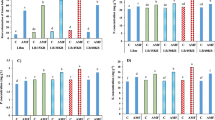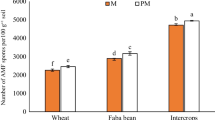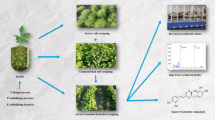Abstract
Implementing intercropping systems with biofertilizer applications is a sustainable and eco-friendly strategy for improving the quantity and quality of plant products. This study evaluates the impact of biofertilizers in intercropping patterns (kidney bean/sesame) on soil biological activity, nutrient concentration, seed productivity, and sesame oil quantity and quality. The experimental cropping patterns included sesame monocropping (Sm), kidney bean monocropping (KBm), 1 row sesame + 1 row kidney bean intercropping (1S:1 KB), 2 rows sesame + 2 rows kidney bean intercropping (2S:2 KB), 2 rows sesame + 4 rows kidney bean intercropping (2S:4 KB), and 4 rows sesame + 2 rows kidney bean intercropping (4S:2 KB), with co‑inoculation of arbuscular mycorrhizal fungi (Funneliformis mosseae) + bacterial fertilizer (mixture of phosphate-solubilizing bacteria Pantoea agglomerans + Pseudomonas putida and N-fixing bacteria Azotobacter vinelandii) and an unfertilized control. The 2S:4 KB intercropping ratio with biofertilizer application had the highest soil microbial and enzyme activities. The biofertilizer application on the monocrops produced the highest sesame and kidney bean seed yields (28.9% and 10.3% higher than the unfertilized control, respectively). The 4S:2 KB intercropping ratios with biofertilizer application produced the highest oleic (49.90%) and linoleic acids (33.83%) in sesame oil, and the 2S:2 KB intercropping ratio with biofertilizer application had the greatest land equivalent ratio (1.38). We conclude that the 2S:2 KB and 4S:2 KB intercropping ratios with biofertilizer application could be environmentally friendly solutions for improving sesame oil quantity and quality.








Similar content being viewed by others
Data Availability
Data that support the findings of this study are available on request from the corresponding author. The data are not publicly available due to privacy or ethical restrictions.
References
Abdel-Salam E, Alatar A, El-Sheikh MA (2018) Inoculation with arbuscular mycorrhizal fungi alleviates harmful effects of drought stress on damask rose. Saudi J Biol Sci 25:1772–1780. https://doi.org/10.1016/j.sjbs.2017.10.015
Akbari P, Ghalavand A, Modares Sanavy AM, AghaAlikhani M, Shoghi Kalkhoran S (2011) Comparison of different nutritional levels and the effect of plant growth promoting rhizobacteria (PGPR) on the grain yield and quality of sunflower. Aust J Crop Sci 5:1570–1576
Alef K, Nannipieri P (1995) Methods in applied soil microbiology and biochemistry. Academic Press, London, UK
Amani Machiani M, Rezaei-Chiyaneh E, Javanmard A, Maggi F, Morshedloo MR (2019) Evaluation of kidney beans (Phaseolus vulgaris L.) seed yield and quali-quantitative production of the essential oils from fennel (Foeniculum vulgare Mill.) and dragonhead (Dracocephalum moldavica L.) in intercropping system under humic acid application. J Clean Prod 235:112–122. https://doi.org/10.1016/j.jclepro.2019.06.241
Amani Machiani M, Javanmard A, Morshedloo MR, Aghaee A, Maggi F (2021) Funneliformis mosseae inoculation under water deficit stress improves the yield and phytochemical characteristics of thyme in intercropping with soybean. Sci Rep 11:15279. https://doi.org/10.1038/s41598-021-94681-9
Anderson TH, Domsch KH (1993) The metabolic quotient for CO2 (qCO2) as a specific activity parameter to assess the effects of environmental conditions, such as ph, on the microbial biomass of forest soils. Soil Biol Biochem 25:393–395. https://doi.org/10.1016/0038-0717(93)90140-7
Anli M, Baslam M, Tahiri A, Raklami A, Symanczik S, Boutasknit A, Ait-El-Mokhtar M, Ben-Laouane R, Toubali S, Ait Rahou Y, Ait Chitt M, Oufdou K, Mitsui T, Hafidi M, Meddich, A (2020) Biofertilizers as strategies to improve photosynthetic apparatus, growth, and drought stress tolerance in the date palm. Front Plant Sci 11:516818. https://doi.org/10.3389/fpls.2020.516818
Atudorei D, Stroe SG, Codin GG (2021) Impact of germination on the microstructural and physicochemical properties of different legume types. Plants 10:592. https://doi.org/10.3390/plants.10030592
Bai YC, Li BX, Xu CY, Raza M, Wang Q, Wang QZ, Fu YN, Hu JY, Imoulan A, Hussain M, Xu YJ (2022) Intercropping walnut and tea: effects on soil nutrients, enzyme aactivity, and microbial communities. Front Microbiol 18(13):852342. https://doi.org/10.3389/fmicb.2022.852342
Begum N, Qin C, Ahanger MA, Raza S, Khan MI, Ashraf M, Ahmed N, Zhang L (2019) Role of arbuscular mycorrhizal fungi in plant growth regulation: implications in abiotic stress tolerance. Front Plant Sci 10:1–15. https://doi.org/10.3389/fpls.2019.01068
Chau CF, Ciou JY, Wu CL (2021) Commercialized sesame oil analysis: quality characterization and oxidative stability of blended sesame oil. ACS Food Sci Technol 1:1222–1227. https://doi.org/10.1021/acsfoodscitech.1c00008
Chekanai V, Chikowo R, Vanlauwe B (2018) Response of kidney beans (Phaseolus vulgaris L.) to nitrogen, phosphorus and rhizobia inoculation across variable soils in Zimbabwe. Agric Ecosyst Environ 266:167–173. https://doi.org/10.1016/j.agee.2018.08.010
Dick WA, Cheng L, Wang P (2000) Soil acid and alkaline phosphatase activity as pH adjustment indicators. Soil Biol Biochem 32:1915–1919. https://doi.org/10.1016/S0038-0717(00)00166-8
Duchene O, Vian JF, Celette F (2017) Intercropping with legume for agroecological cropping systems: complementarity and facilitation processes and the importance of soil microorganisms. A Review Agric Ecosyst Environ 240:148–161. https://doi.org/10.1016/j.agee.2017.02.019
Faridvand Sh, Rezaei-Chiyaneh E, Battaglia ML, Gitari HI, Raza MA, Siddique KHM (2021) Application of bio and chemical fertilizers improves yield, and essential oil quantity and quality of Moldavian balm (Dracocephalum moldavica L.) intercropped with mung bean (Vigna radiata L.). Food Energy Secur 00:e319. https://doi.org/10.1002/fes3.319
Fotohi-Chiyaneh S, Rezaei-Chiyaneh E, Amirnia R, Keshavarz Afshar R, Kadambot HMS (2022) Changes in the essential oil, fixed oil constituents, and phenolic compounds of ajowan and fenugreek in intercropping with pea affected by fertilizer sources. Ind Crops Prod 178:114587. https://doi.org/10.1016/j.indcrop.2022.114587
Ghaderimokri L, Rezaei-Chiyaneh E, Ghiyasi M, Gheshlaghi M, Battaglia ML, Siddique KHM (2022) Application of humic acid and biofertilizers changes oil and phenolic compounds of fennel and fenugreek in intercropping systems. Sci Rep 12:5946. https://doi.org/10.1038/s41598-022-09645-4
Gholinezhad E, Darvishzadeh R (2021) Influence of arbuscular mycorrhiza fungi and drought stress on fatty acids profile of sesame (Sesamum indicum L.). F Crop Res 262:108035. https://doi.org/10.1016/j.fcr.2020.108035
Giovannetti M, Mosse B (1980) An evaluation of techniques for measuring vesicular arbuscular mycorrhizal infection in roots. New Phytol 84:489–500. https://doi.org/10.1111/j.1469-8137.1980.tb04556.x
Gitari HI, Nyawade SO, Kamau S, Karanja NN, Gachene CKK, Raza MA, Maitra S, Schulte-Geldermann E (2020) Revisiting intercropping indices with respect to potato-legume intercropping systems. F Crop Res 258:107957. https://doi.org/10.1016/j.fcr.2020.107957
Jenkinson DS, Powlson DS (1976) The effects of biocidal treatments on metabolism in soil-V. A method for measuring soil biomass. Soil Biol Biochem 8:209–213. https://doi.org/10.1016/0038-0717(76)90005-5
Jones JB (1972) Micronutrients in Agriculture. Society America, Madison, Soil Sci
Kandeler E, Gerber H (1988) Short-term assay of soil urease activity using colorimetric determination of ammonium. Biol Fertil Soils 6:68–72. https://doi.org/10.1007/BF00257924
Krasilnikov P, Taboada MA, Amanullah, (2022) Fertilizer use, soil health and agricultural sustainability. Agriculture 12:462. https://doi.org/10.3390/agriculture12040462
Kumar M, Poonam Ahmad Sh, Singh RP (2022) Plant growth promoting microbes: Diverse roles for sustainable and ecofriendly agriculture. Energy Nexus 7:100133. https://doi.org/10.1016/j.nexus.2022.100133
Kumar S, Diksha Sindhu SS, Kumar R (2022) Biofertilizers: an ecofriendly technology for nutrient recycling and environmental sustainability. Curr Res Microb Sci 3:100094. https://doi.org/10.1016/j.crmicr.2021.100094
Li Y, Li H, Han X, Han G, Xi J, Liu Y, Zhang Y, Xue Q, Guo Q, Lai H (2022) Actinobacterial biofertilizer improves the yields of different plants and alters the assembly processes of rhizosphere microbial communities. Appl Soil Ecol 171:104345. https://doi.org/10.1016/j.apsoil.2021.104345
Maitra S, Hossain A, Brestic M, Skalicky M, Ondrisik P, Gitari H, Brahmachari K, Shankar T, Bhadra P, Palai JB, Jena J, Bhattacharya U, Duvvada SK, Lalichetti S, Sairam M (2021) Intercropping—a low input agricultural strategy for food and environmental security. Agronomy 11:343–371. https://doi.org/10.3390/agronomy11020343
Moradzadeh S, Siavash Moghaddam S, Rahimi A, Pourakbar L, El Enshasy HA, Sayyed RZ (2021) Bio-chemical fertilizer improves the oil yield, fatty acid compositions, and macro-nutrient contents in Nigella sativa L. Horticulturae 7:345–365. https://doi.org/10.3390/horticulturae7100345
Morris JB, Wang ML, Tonnis BD (2021) Variability for oil, protein, lignan, tocopherol, and fatty acid concentrations in eight sesame (Sesamum indicum L) genotypes. Ind Crops Prod 164:113355. https://doi.org/10.1016/j.indcrop.2021.113355
Mouradi M, Farissi M, Makoudi B, Bouizgaren A, Ghoulam C (2018) Effect of faba bean (Vicia faba L.)–rhizobia symbiosis on barley’s growth, phosphorus uptake and acid phosphatase activity in the intercropping system. Ann Agrar Sci 16:297–303. https://doi.org/10.1016/j.aasci.2018.05.003
Namazi Y, Rezaei‑Chiyaneh E, Moghaddam SS, Battaglia ML (2022) The effects of microbial inoculation and intercropping on yield and active ingredients of savory (Satureja hortensis L.) intercropped with common bean (Phaseolus vulgaris L.). Int J Environ Sci Technol 19:8273–8288. https://doi.org/10.1007/s13762-022-04024-y
Nosheen S, Ajmal I, Song Y (2021) Microbes as biofertilizers, a potential approach for sustainable crop production. Sustainability 1:1868. https://doi.org/10.3390/su13041868
Phillips JM, Hayman DS (1970) Improved procedures for clearing roots and staining parasitic and vesicular arbuscular mycorrhizal fungi for rapid assessment of infection. Trans Br Mycol Soc 55:158–161. https://doi.org/10.1016/S0007-1536(70)80110-3
Plaza-Bonilla D, Lampurlanés J, Fernández FG, Cantero-Martínez C (2021) Nitrogen fertilization strategies for improved Mediterranean rainfed wheat and barley performance and water and nitrogen use efficiency. Eur J Agron 124:126238. https://doi.org/10.1016/j.eja.2021.126238
Raza MA, Gul H, Wang J, Yasin HS, Qin R, Bin Khalid MH, Naeem M, Feng LY, Iqbal N, Gitari H, Ahmad S, Battaglia M, Ansar M, Yang F, Yang W (2021) Land productivity and water use efficiency of maize-soybean strip intercropping systems in semi-arid areas: a case study in Punjab Province. Pakistan. J Clean Prod 308:127282. https://doi.org/10.1016/j.jclepro.2021.127282
Rezaei-Chiyaneh E, Amani Machiani M, Javanmard A, Maggi F, Morshedloo MR (2020b) Vermicompost application in different intercropping patterns improves the mineral nutrient uptake and essential oil compositions of sweet basil (Ocimum basilicum L.). J Soil Sci Plant Nutr 21:450–466. https://doi.org/10.1007/s42729-020-00373-0
Rezaei-Chiyaneh E, Amirnia R, Amani Machiani M, Javanmard A, Maggi F, Morshedloo MR (2020a) Intercropping fennel (Foeniculum vulgare L.) with common beans (Phaseolus vulgaris L.) as affected by PGPR inoculation: a strategy for improving yield, essential oil and fatty acid composition. Sci Hortic 261:108951. https://doi.org/10.1016/j.scienta.2019.108951
Rezaei-Chiyaneh E, Amirnia R, Fotohi Chiyaneh S, Maggi F, Barin M, Razavi BS (2021a) Improvement of dragonhead (Dracocephalum moldavica L.) yield quality through a coupled intercropping system and vermicompost application along with maintenance of soil microbial activity. Land Degrad Dev 32:2679–2874. https://doi.org/10.1002/ldr.3957
Rezaei-Chiyaneh E, Jalilian J, Seyyedi SM, Barin M, Ebrahimian E, Keshavarz Afshar R (2021d) Isabgol (Plantago ovata) and lentil (Lens culinaris) intercrop response to arbuscular mycorrhizal fungi inoculation. Biol Agric Hortic 37:125–140. https://doi.org/10.1080/01448765.2021.1903556
Rezaei-Chiyaneh E, Mahdavikia H, Battaglia ML, Thomason WE, Caruso G (2021c) Intercropping and fertilizer type impact seed productivity and secondary metabolites of dragon’s head and fenugreek. Sci Hortic (Amsterdam) 287:110277. https://doi.org/10.1016/j.scienta.2021.110277
Rezaei-Chiyaneh E, Battaglia ML, Sadeghpour A, Shokrani F, Nasab ADM, Raza MA, Von Cossel M (2021b) Optimizing intercropping systems of black cumin (Nigella sativa L.) and fenugreek (Trigonella foenum-graecum L.) through inoculation with bacteria and mycorrhizal fungi. Adv Sustain Syst 5:2000269. https://doi.org/10.1002/adsu.202000269
Rossato L, Lainé P, Ourry A (2001) Nitrogen storage and remobilization in Brassica napus L. during the growth cycle: nitrogen fluxes within the plant and changes in soluble protein patterns. J Exp Bot 361:1655–1663. https://doi.org/10.1093/jexbot/52.361.1655
Sabannavar SJ, Lakshman HC (2011) Synergistic interactions among Azotobacter, Pseudomonas, and arbuscular mycorrhizal fungi on two varieties of Sesamum indicum L. Commun Soil Sci Plant Anal 42(17):2122–2133. https://doi.org/10.1080/00103624.2011.596241
Shu-tian L, Yu D, Tian-wen G, Ping-liang Z, Ping H, Majumdar K (2018) Sunflower response to potassium fertilization and nutrient requirement estimation. J Integr Agric 17:2802–2812. https://doi.org/10.1016/S2095-3119(18)62074-X
Suchithra MR, Muniswami DM, Sri MS, Usha R, Rasheeq AA, Preethi BA, Dineshkumar R (2022) Effectiveness of green microalgae as biostimulants and biofertilizer through foliar spray and soil drench method for tomato cultivation. South African J Bot 146:740–750. https://doi.org/10.1016/j.sajb.2021.12.022
Tabatabai MA, Bremner JM (1969) Use of p-nitrophenyl phosphate for assay of soil phosphatase activity. Soil Biol Biochem 1:301–307. https://doi.org/10.1016/0038-0717(69)90012-1
Tandon HLS, Cescas MP, Tyner EH (1968) An acid-free vanadate-molybdate reagent for the determination of total phosphorus in soils. Soil Sci Soc Am J 32:48–51. https://doi.org/10.2136/sssaj1968.03615995003200010012x
Thilakarathna MS, McElroy MS, Chapagain T, Papadopoulos YA, Raizada MN (2016) Belowground nitrogen transfer from legumes to non-legumes under managed herbaceous cropping systems. Rev Agron Sustain Dev 36:58. https://doi.org/10.1007/s13593-016-0396-4
Wangiyana W, Aryana IGPM, Dulur NWD (2021) Mycorrhiza biofertilizer and intercropping with soybean increase anthocyanin contents and yield of upland red rice under aerobic irrigation systems. IOP Conf Series: Earth Environ Sci 637:012087. https://doi.org/10.1088/1755-1315/637/1/012087
Yanni Y, Zidan M, Dazzo F, Rizk R, Mehesen A, Abdelfattah F, Elsadany A (2016) Enhanced symbiotic performance and productivity of drought stressed kidney beans after inoculation with tolerant native rhizobia in extensive fields. Agric Ecosyst Environ 232:119–128. https://doi.org/10.1016/j.agee.2016.07.006
Zamani F, Amirnia R, Rezaei-Chiyaneh E, Gheshlaghi M, von Cossel M, Siddique KHM (2022) Optimizing essential oil, fatty acid profiles, and phenolic compounds of dragon's head (Lallemantia iberica) intercropped with chickpea (Cicer arietinum L.) with biofertilizer inoculation under rainfed conditions in a semi-arid region. Arch Agron Soil Sci. https://doi.org/10.1080/03650340.2022.2105320
Zhong S, Zeng HC (2019) Effect of peanut (Arachis hypogaea L.)/cowpea (Vigna unquiculata L.) intercropping combined with organic mature application on soil microfauna. Geoderma 354:113863. https://doi.org/10.1016/j.geoderma.2019.07.021
Author information
Authors and Affiliations
Corresponding author
Ethics declarations
Conflict of Interest
The authors declare no competing interests.
Additional information
Publisher's Note
Springer Nature remains neutral with regard to jurisdictional claims in published maps and institutional affiliations.
Supplementary Information
Below is the link to the electronic supplementary material.
Rights and permissions
Springer Nature or its licensor (e.g. a society or other partner) holds exclusive rights to this article under a publishing agreement with the author(s) or other rightsholder(s); author self-archiving of the accepted manuscript version of this article is solely governed by the terms of such publishing agreement and applicable law.
About this article
Cite this article
Taghizadeh, Y., Amirnia, R., Rezaei-Chiyaneh, E. et al. Co-Inoculation of Mycorrhizal Fungi with Bacterial Fertilizer Along with Intercropping Scenarios Improves Seed Yield and Oil Constituents of Sesame. J Soil Sci Plant Nutr 23, 2258–2272 (2023). https://doi.org/10.1007/s42729-023-01177-8
Received:
Accepted:
Published:
Issue Date:
DOI: https://doi.org/10.1007/s42729-023-01177-8




